Santa Monica, California______________________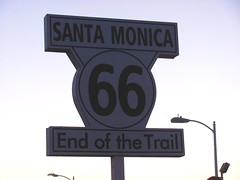
The idea of the journey or the open road has traditionally been central to American identity. From Manifest Destiny, to the Oregon Trail, and eventually Route 66, the universal commonality shared by these cultural icons is the existential search for the freedom and yet-unrealized possibilities granted by the act of “going west”. Although it has mostly been decommissioned, there are still portions of historic Route 66 that are drivable, and they still lead to the same destination in Santa Monica, California. So, what do we find at this destination, the place of yearning that has always been the cornerstone to what it means to be an American?
The answer: A fairly lame Morgan Manufacturing family roller coaster. Remember (as the car commercials always tell us), it’s not the destination but the journey that really matters.
family roller coaster. Remember (as the car commercials always tell us), it’s not the destination but the journey that really matters.
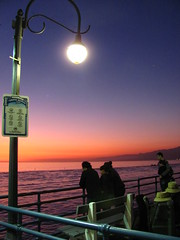 Terminating the western end of historic Route 66 is the Santa Monica Pier; primarily home to the Pacific Park rides midway as well as an eclectic array of buskers, hawkers, vagabonds, and tourists. Plus some lovely sunset views of the Pacific Ocean, if you’re into that sort of thing. Some may find it all charming, others may find
Terminating the western end of historic Route 66 is the Santa Monica Pier; primarily home to the Pacific Park rides midway as well as an eclectic array of buskers, hawkers, vagabonds, and tourists. Plus some lovely sunset views of the Pacific Ocean, if you’re into that sort of thing. Some may find it all charming, others may find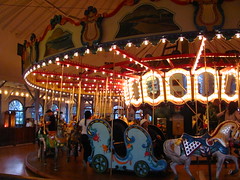 it tacky or a tad unsavory, but there’s no doubt that it’s a popular destination for both visitors and locals alike. On the walkway in the pier appeared to be swarmed with people, although part of this was the perspective of looking straight down a long, flat boardwalk.
it tacky or a tad unsavory, but there’s no doubt that it’s a popular destination for both visitors and locals alike. On the walkway in the pier appeared to be swarmed with people, although part of this was the perspective of looking straight down a long, flat boardwalk.
There’s also a 1922 Charles Looff Carousel on the Santa Monica Pier that’s not formally part of Pacific Park, but well worth a look inside the Looff Hippodrome which houses the carousel, even if you’re not planning to buy a ticket to ride.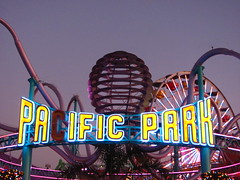 This 1916-built structure has a distinctive architectural style that combines Byzantine, Moorish, and California styles (so I am informed by a marker inside the building) and was declared a National Historic Landmark in 1987. It’s certainly an elegant presentation to a simple attraction that I regret is missing from most modern amusement parks.
This 1916-built structure has a distinctive architectural style that combines Byzantine, Moorish, and California styles (so I am informed by a marker inside the building) and was declared a National Historic Landmark in 1987. It’s certainly an elegant presentation to a simple attraction that I regret is missing from most modern amusement parks.
Pacific Park, for better or worse, is a marked contrast to classical beauty of the Looff Hippodrome, featuring instead a bright, eye-catching color palate and lots of neon and tracer lights. A hyper-contemporary aesthetic that works well in its context, although it runs the risk that a broken neon light will quickly transform it from “looking cool” to “looking trashy”.
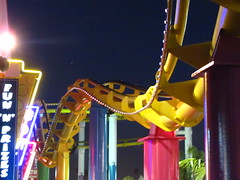 Pacific Park is primarily known for the Pacific Wheel, a solar-powered Ferris Wheel with an impressive LED lighting package, and the famous West Coaster, which has appeared in countless movies, TV shows, and commercials whenever the producers don’t feel like paying to send their film crew out to San Diego or
Pacific Park is primarily known for the Pacific Wheel, a solar-powered Ferris Wheel with an impressive LED lighting package, and the famous West Coaster, which has appeared in countless movies, TV shows, and commercials whenever the producers don’t feel like paying to send their film crew out to San Diego or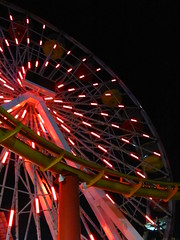 Santa Cruz to film a real oceanfront roller coaster. It is also home to a small collection of generic flat rides such as a Scrambler, Sea Dragon, and Bumper Cars, most of them a tad overpriced at $5.00 a ticket. There’s an unlimited wristband option
Santa Cruz to film a real oceanfront roller coaster. It is also home to a small collection of generic flat rides such as a Scrambler, Sea Dragon, and Bumper Cars, most of them a tad overpriced at $5.00 a ticket. There’s an unlimited wristband option around $22.00, but since both the West Coaster and the Pacific Wheel cost the same as the flat rides you can probably save yourself a bit of scratch by buying a one-time ticket for those and saving the others for the next time you’re at a cheap carnival or a pay-one-price park.
around $22.00, but since both the West Coaster and the Pacific Wheel cost the same as the flat rides you can probably save yourself a bit of scratch by buying a one-time ticket for those and saving the others for the next time you’re at a cheap carnival or a pay-one-price park.
I wonder what the average time it takes for people to realize the name of the West Coaster is also a really bad pun. D.H. Morgan Manufacturing were given a logistical challenge when it was decided they would design a roller coaster layout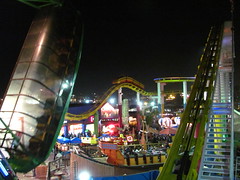 that could fit inside the limited space offered by the pier, and for the most part they avoided the challenge by playing it as safe as possible. The roller coaster (it uses exact same ride system as the Morgan hypercoasters) forms a simple out-and-back layout around Pacific Park, with the station and final helix fitted inside the only small plot of pier estate that was available to them, and the rest of the layout was elevated to go above the pre-existing midways. A functional if not very original design, made worse by the fact that without the high speeds of their hypercoasters the dynamics are even tamer, as they use the same profiling techniques. It’s a decent coaster for kids and grandparents, but nothing that anyone who had been to any of Southern California’s other major theme parks would write home about.
that could fit inside the limited space offered by the pier, and for the most part they avoided the challenge by playing it as safe as possible. The roller coaster (it uses exact same ride system as the Morgan hypercoasters) forms a simple out-and-back layout around Pacific Park, with the station and final helix fitted inside the only small plot of pier estate that was available to them, and the rest of the layout was elevated to go above the pre-existing midways. A functional if not very original design, made worse by the fact that without the high speeds of their hypercoasters the dynamics are even tamer, as they use the same profiling techniques. It’s a decent coaster for kids and grandparents, but nothing that anyone who had been to any of Southern California’s other major theme parks would write home about.
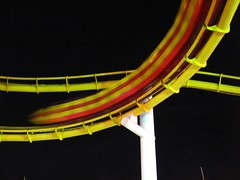 There are still a few things to like about this gentle coaster. While the speeds max out at a mere 35 mph, it at least manages to do that near the end of the layout rather than at the beginning, which starts out with a slow downward helix that gradually builds momentum and excitement, rather than start out with a big drop and have every subsequent element measure up short by comparison. The two bunny hops
There are still a few things to like about this gentle coaster. While the speeds max out at a mere 35 mph, it at least manages to do that near the end of the layout rather than at the beginning, which starts out with a slow downward helix that gradually builds momentum and excitement, rather than start out with a big drop and have every subsequent element measure up short by comparison. The two bunny hops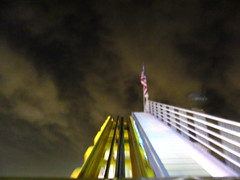 over the midway have a slight whiff of more airtime than on the return leg of
over the midway have a slight whiff of more airtime than on the return leg of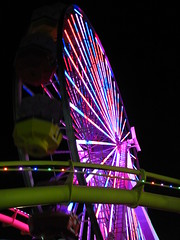 World of Fun’s Mamba; not that that means we’re at all close to achieving weightlessness. And the final helix is the most rousing and energetic part of the entire ride, with the only section of track that actually dips all the way down to boardwalk level, and if you’re in the front row, there’s even a small pop of honest-to-goodness
World of Fun’s Mamba; not that that means we’re at all close to achieving weightlessness. And the final helix is the most rousing and energetic part of the entire ride, with the only section of track that actually dips all the way down to boardwalk level, and if you’re in the front row, there’s even a small pop of honest-to-goodness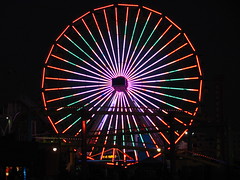 real airtime on the sharp incline back into the brakes. The roller coaster is over so quickly that they give you two laps, which make the $5.00 spent on a ticket feel satisfactory, not that I would feel compelled to plonk down another fiver for another two laps on the same night. The West Coaster and Santa Monica Pier are one of those things that I’d always feel obligated to do at least once whenever I’m in Southern California, and would recommend anyone else visiting the area to do the same, despite the fact that I also feel that it’s not quite worthy of the heritage of boardwalk amusement parks along the west coast.
real airtime on the sharp incline back into the brakes. The roller coaster is over so quickly that they give you two laps, which make the $5.00 spent on a ticket feel satisfactory, not that I would feel compelled to plonk down another fiver for another two laps on the same night. The West Coaster and Santa Monica Pier are one of those things that I’d always feel obligated to do at least once whenever I’m in Southern California, and would recommend anyone else visiting the area to do the same, despite the fact that I also feel that it’s not quite worthy of the heritage of boardwalk amusement parks along the west coast.

Comments